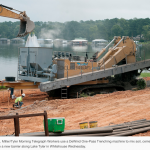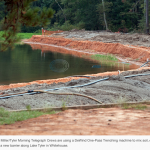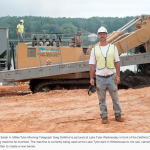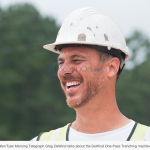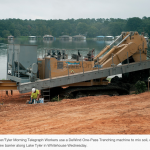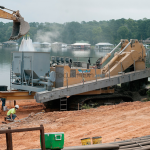Article about fixing a dam with a DeWind One-Pass-Trencher.
One-Pass-Trencher used to repair Tyler Dam.
Greg DeWind takes pride in his one-pass trenching machine.
With a smile on his face, he watches Wednesday as it is used to dig a trench at the Lake Tyler Dam. The 225,000-pound, 3,000-horsepower machine mixes soil, cement and bentonite clay as it cuts a trench that is 2 1/2-foot wide and about 70 feet deep, according to Steve Richards, with ETTL Engineers and Consultants. It burns about 100 gallons of fuel per hour.
- DeWind One Pass Trencher Repairs Tyler Dam.
“We enjoy it because it’s one of a kind,” said DeWind, president of Michigan-based DeWind One-Pass Trenching. The DeWind One-Pass Trencher, which DeWind built with his sons, arrived in East Texas last week and is being used as part of the Lake Tyler Dam repair project. The project involves repairing the dam and spillway at 18261 Concession Road in Whitehouse. Gracon Construction is the general contractor, while DeWind One-Pass Trenching is a specialty subcontractor. WisenbakerFix & Associates is the main consultant. ETTL Engineers and Consultants, along with Dr. Garry Gregory, have made up the specialty geotechnical consultant team.
Greg Morgan, managing director of utilities and public works for the city of Tyler, said earlier this year that the dam was inspected in 2010, at which time boils were discovered, meaning water was coming up through the dam and transporting soil.
Morgan said the boils weren’t leaking or bubbling up a large amount of water, but, if not addressed, had the potential to create a structural problem with the dam. The city went ahead with the $8.3 million project, which is being funded with monies from the Tyler Water Utilities capital improvement fund.
Morgan said years of preparatory work, such as design and analysis, took place, and a notice to proceed with the project was issued in May.
He said part of the project was to fill in some voids that were under the spillway so that construction could begin on a portion of the wall that goes in front of the spillway.
“They’ve been doing a lot of work up to this point getting ready to bring that piece of equipment (the trenching machine) on site,” he said.
Morgan said a barrier wall was not originally constructed with the lake, and instead, a collection system was designed to collect seepage from the base of the dam and discharge it into the nearby tributary mud creek.
Seepage will still occur out of the lake once a barrier wall is built, but water won’t migrate through the dam, which is what could potentially cause a structural problem, Morgan said. In other words, he said, the wall will not impact the lake level, but will keep water from seeping through the dam.
“What you don’t want the seepage to do is surface. We don’t want it to migrate through the dam. It can go out the base of the dam, but if it migrates through the dam, that has the potential of being an issue,” he said.
Although the deep cutoff wall is “the meat of the project,” he said the project also includes reconstructing part of Concession Road. He said that’s necessary because of damage to the road from bringing in big equipment for the project.
The Lake Tyler Dam Repair project is expected to be complete by December.
In the meantime, DeWind One-Pass Trenching will continue working at Lake Tyler for about the next month and a half.
Unique Machine
DeWind’s story started in Michigan, where he grew up. He was involved with his father’s water well drilling company before starting his own dewatering company, which, he said, used wells to lower the water table to put in drainage pipes.
After leaving the dewatering company, DeWind said he ultimately started working with trenching machines and built a trencher to put drain tile under the ground.
He said he then found out that excavators were being used to build barrier walls and realized the machines he built could build a wall faster and with a better mix.
DeWind started enlarging these trenching machines to stay ahead of other companies doing the same thing.
Richards described the DeWind One-Pass Trencher at Lake Tyler as “unique.”
Richards said the machine is used on sites when it is necessary to dig a deep trench.
Additionally, it’s used to contain the pollutants that sometimes flow through the ground, and in water supply reservoirs where there is underground leakage, he said.
Richards said overall he is pleased with the machine’s mixing process. In fact, he said the mixture is “like peanut butter” because the machine mixes so well.
“Good mixture is essential to significantly reduce the water leakage through the soil,” he said.
The machine being used at Lake Tyler took two years to build and is one of DeWind’s eight trenching machines.
Now, Richards said, DeWind is in the process of building a trenching machine that goes 125 feet into the ground.
“He started out small and realized what he was building was bigger than anything he could buy anywhere, and he just kept making it bigger and bigger,” he said.
|
|
© 2012 Dewind. All Rights Reserved.Designed by Planted Meida
